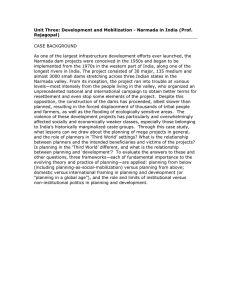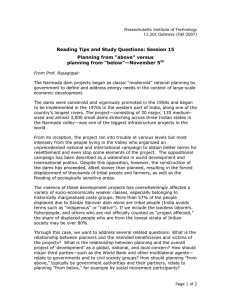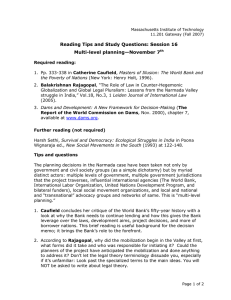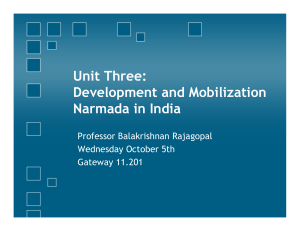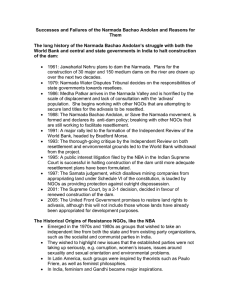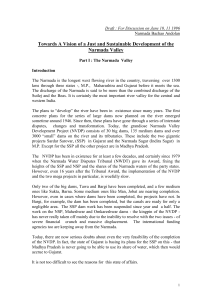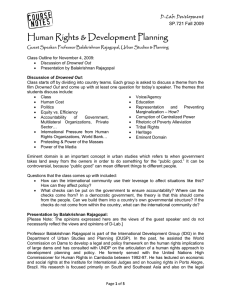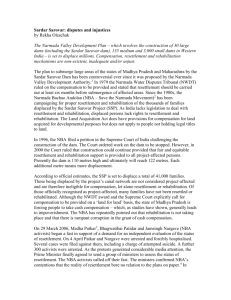Reading Tips and Study Questions: For Session 8
advertisement
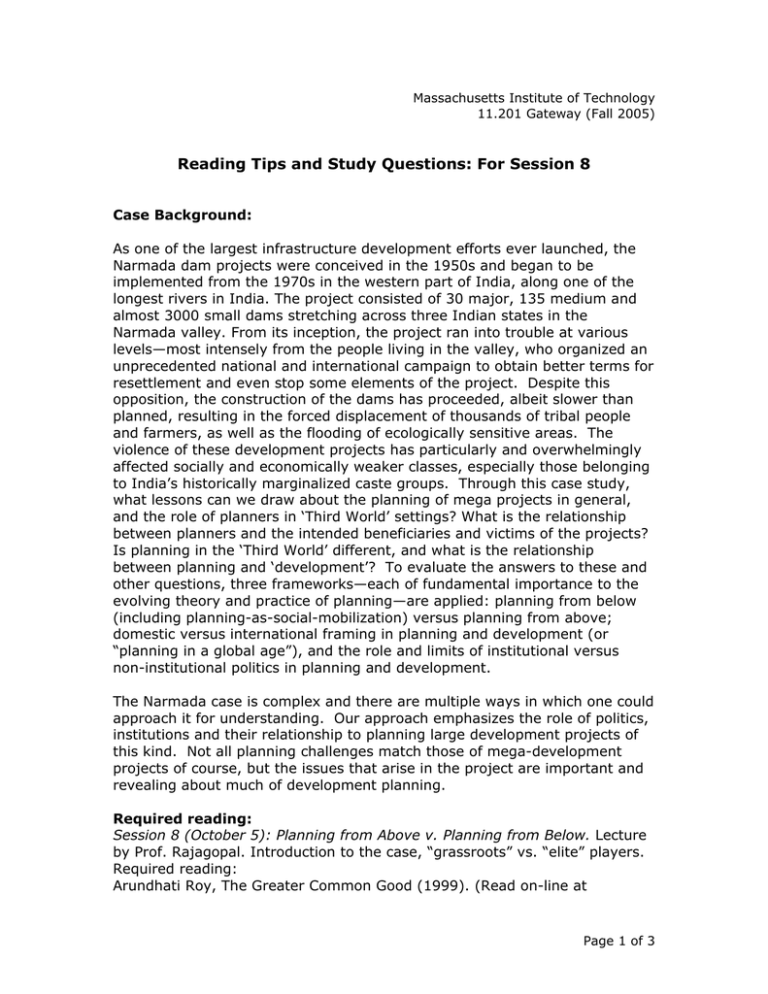
Massachusetts Institute of Technology 11.201 Gateway (Fall 2005) Reading Tips and Study Questions: For Session 8 Case Background: As one of the largest infrastructure development efforts ever launched, the Narmada dam projects were conceived in the 1950s and began to be implemented from the 1970s in the western part of India, along one of the longest rivers in India. The project consisted of 30 major, 135 medium and almost 3000 small dams stretching across three Indian states in the Narmada valley. From its inception, the project ran into trouble at various levels—most intensely from the people living in the valley, who organized an unprecedented national and international campaign to obtain better terms for resettlement and even stop some elements of the project. Despite this opposition, the construction of the dams has proceeded, albeit slower than planned, resulting in the forced displacement of thousands of tribal people and farmers, as well as the flooding of ecologically sensitive areas. The violence of these development projects has particularly and overwhelmingly affected socially and economically weaker classes, especially those belonging to India’s historically marginalized caste groups. Through this case study, what lessons can we draw about the planning of mega projects in general, and the role of planners in ‘Third World’ settings? What is the relationship between planners and the intended beneficiaries and victims of the projects? Is planning in the ‘Third World’ different, and what is the relationship between planning and ‘development’? To evaluate the answers to these and other questions, three frameworks—each of fundamental importance to the evolving theory and practice of planning—are applied: planning from below (including planning-as-social-mobilization) versus planning from above; domestic versus international framing in planning and development (or “planning in a global age”), and the role and limits of institutional versus non-institutional politics in planning and development. The Narmada case is complex and there are multiple ways in which one could approach it for understanding. Our approach emphasizes the role of politics, institutions and their relationship to planning large development projects of this kind. Not all planning challenges match those of mega-development projects of course, but the issues that arise in the project are important and revealing about much of development planning. Required reading: Session 8 (October 5): Planning from Above v. Planning from Below. Lecture by Prof. Rajagopal. Introduction to the case, “grassroots” vs. “elite” players. Required reading: Arundhati Roy, The Greater Common Good (1999). (Read on-line at Page 1 of 3 http://www.flonnet.com/fl1611/16110040.htm) Sanjeev Khagram, Dams and development: Transnational Struggles for Water and Power (2005), chapter 3. Smitu Kothari, Damming the Narmada and the Politics of Development, in Fisher, ed., Toward Sustainable Development? Struggling over India's Narmada River (1995) at 421-444. Balakrishnan Rajagopal, 'The Violence of Development', Washington Post, August 8, 2001 Tips and questions 1. What is Development and what is Planning? Can we think of development as modernity? As nationalism? As exploitation/extraction? As technocratic antipolitics? Consider how Kothari and Roy link the critique of the project to a broader critique of democracy and the nature of development itself. 2. Planning from above: Are mega projects compatible with democracy at all? Should democracy be judged by outcome or process? Think about the impact of India’s democratic system on the way the project was conceived, planned and implemented and whether democracy led to better outcomes, and if so, how we can tell what is better? 3. Planning from below: Is mobilization effective and if so how do we judge when it is? If social mobilization is an important part of planning from below (according to Friedman), whose mobilization and politics matter for development? Did the NBA succeed in attaining its goals and if not, how can we explain the outcomes they did achieve such as better terms of resettlement and rehabilitation from the Gujarat government in the late 1980s and compelling the World Bank to pull put its funding, as Khagram explains? 4. City versus Rural divide: Consider who benefits and loses in the case and how we are to judge what benefits and losses are. Roy explicitly links big projects like Narmada with the production of poverty in cities, especially the growth of slums. Are you persuaded? What methods and scholarly frameworks are needed to assess internal displacement and migration and should planners learn how to assess such societal impacts? 5. The ethnic/racial/caste dimension: Consider the facts about who gets displaced due to large development projects and why. More than 57% of the displaced people due to the Sardar Sarovar dam alone, are tribal people (India avoids the terms like ‘indigenous’ or ‘native’). If we include the landless laborers, fisherpeople and others who are not officially counted as ‘project affected’, the percentage of the population from the lowest socio-economic strata of Indian society who are adversely affected by the Narmada project may be well over 80%. Is this ethnic cleansing in disguise as Prof. Rajagopal argues? 6. Problems of implementation: The project has suffered from several lacunae in implementation: for instance, the problems of finding adequate Page 2 of 3 land for resettlement, keeping communities intact, and ensuring project goals are met including through post-project review. Indeed, in postindependence India, not even a single dam has been subjected to a thorough post-project assessment, even by applying a benefit/cost analysis. Is a project of this size capable of being implemented without problems? Based on the Narmada experience (as you read it), are big projects feasible at all, as planned interventions? Page 3 of 3
